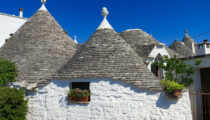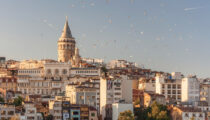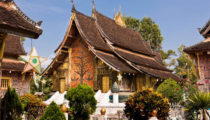September 25, 2009
Porticos of Bologna
Porticos are as essential to Bologna as gourmet food and university students. The distinctive covered walkways course 38 kilometers (more than 23 miles) through this attractive and very walkable city in the Emilia-Romagna region of northern Italy, sheltering pedestrians and window-shoppers from the elements while providing access to daylight and fresh air.
Porticos typically flow smoothly from one building to the next, but architectural styles and materials can vary greatly. For example, columns might be round, square, octagonal or tapered, and ceilings can be flat, barrel-vaulted or groin-vaulted. Bologna’s oldest extant porticos date from the medieval period and are made of unadorned wood. Most porticos, however, are built of terracotta, stone, Bologna’s distinctive red brick, or a combination of these.
The most beautiful porticos in the city are like open-air art galleries that can be enjoyed rain or shine. While strolling along terrazzo floors, you can admire marble columns topped with delicately carved capitals and gaze overhead at elaborately frescoed ceilings. The frescoes are works of art featuring family crests, mythological creatures, and even a celebration of wine.
Bologna’s longest and perhaps most famous portico climbs nearly four kilometers (more than two miles) up the bucolic slopes of Monte della Guardia to the Sanctuary of the Madonna of San Luca. Built over a centuries-old pilgrimage route and completed in 1732, the portico has 666 arches and panoramic views over the rolling Emilia-Romagna countryside. (Fans of John Grisham might remember this portico from the writer’s 2005 novel The Broker, part of which was set in Bologna.)
The porticos of Bologna also tell an interesting story about the development of the city and its world-renowned university. Originating in 1088, the University of Bologna is considered the oldest university in Europe. From early on, an influx of students from across the Continent created a housing shortage. Bologna sought to remedy the situation by allowing homeowners to expand their dwellings toward the street—leading to the portico solution—provided they took in students as boarders.
By the 13th century, porticos had become increasingly popular in Bologna, and in 1288, the city passed a law dictating that porticos be built on private land on all streets where they were considered useful. In 1363, the city restricted any further construction of wooden porticos—a trace of which still exist today—and brick and stone soon became the most commonly used materials.
Today, Bologna’s porticos connect destinations throughout the city, from the classroom to the church, the post office to the pasta shop, and they add visual cohesion and architectural complexity to the cityscape. Already protected by the municipal and national governments, Bologna’s porticos have been submitted to UNESCO to be considered for World Heritage status.
Our private tours of Bologna frequently combine the best of the city’s art and food, and include strolling through some of the most interesting and beautifully frescoed porticos; touring historic palaces, university buildings and other landmarks; touring the Jewish Quarter; browsing the extensive gourmet food markets (some of the best in Italy); and stopping for a meal of some of Bologna’s culinary specialties, such as tortellini, tagliatelle, mortadella and, of course, ragu alla bolognese.
We also arrange private touring in Padua and Turin, two more great Italian cities with extensive porticos (in addition to other wonderful attractions).

 MENU
MENU



